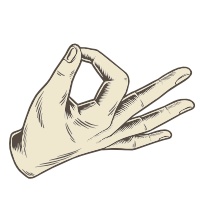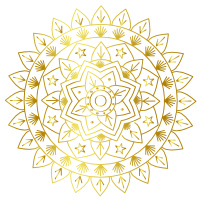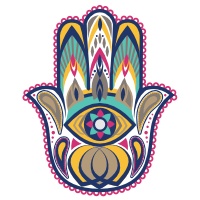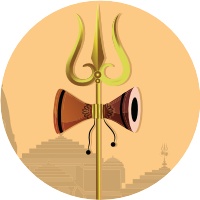Yoga and meditation are rich in mystical symbolism. Yet modern yoga has both commercialized and overlooked many of the deeper meanings of these ancient sacred symbols. Many practitioners use symbols as a way to express their dedication and love of yoga by using them on clothing, jewelry, or even tattoos. But these symbols are not just decoration–knowing and understanding yogic symbols is an integral path to obtaining a deeper knowledge of the yogic philosophies, teachings, and mythologies. Yoga symbols are a powerful tool to create insight and a deeper understanding of the practice of yoga. They visually convey a concept, teaching, or spiritual idea that can be used in your yoga or meditation practice to focus the mind and induce a state of contemplation and absorption.
What Are Yoga Symbols
A symbol is a graphical representation of an idea, concept, or relationship. Symbols can create potent links between very different concepts and experiences to enable us to move from the unknown to the known. Mystics from India created yoga symbols to elevate consciousness and bring deeper insight into one’s spiritual path and yoga practice. They, therefore, are important in communicating deeper truths and to guide one toward achieving inner peace and enlightenment.
How to Use Yoga Symbols
There are several ways you can use yoga symbols to enrich and deepen your yoga and meditation practice. Having one or more of these symbols around one’s living and practice space can help you obtain high levels of inspiration and spiritual energy. You can incorporate yoga symbols into your wardrobe, you can wear jewelry with the symbols on it, or you can even find decorative pieces with the symbols, to place in your home. Just having the symbols close by you will elevate your yoga practices and boost your concentration, inner peace, and connection with the Devine. You may wish to place one or more yoga symbols in your practice space with specific intentions for utilizing them. They can serve as a visual reminder to return to your intention whenever you see them. You can also place one of these images in front of you to gaze at while practicing meditation or yoga poses.
Common Symbols in Yoga
Many of the following common symbols are not limited to just yoga. The power of symbols is their universal appeal, so these icons may also be found in many other cultures, religions, and spiritual practices. The mystery of the symbols can contain several layers of meaning that require the use of contemplation and study to unlock.
The Om/Aum Symbol
The Om or Aum symbol is the most common symbol in Yoga and you will often encounter this image in at your local yoga studio. It is often chanted at the beginning and end of a yoga or meditation class. Yogis believe that the sound or vibration of Om unifies everything in the universe. It is believed that the chanting Om and meditating on the Om symbol can open your third eye and connect to the divine force of the universe. This image represents the primary goal of yoga to unite the mind, body, and spirit.
The three different sounds of Om (A-U-M) represent the three aspects of the Hindu Trimurti: Brahma the creator (A), Vishnu the sustainer (U) and the Shiva the transformer (M). The representation and sound of Aum can also be broken down into four meanings.
- The bottom left curve represents the sound of A (aahh) and the first or waking state of consciousness. This is our conscious mind and where we experience the world through the 5 senses.
- The bottom right curve represents the sound of U (oohh) and the second or dreaming state of consciousness. We experience this beyond our physical bodies in our active unconsciousness and energetic realms.
- The top left curve represents the sound of M (mmm) and the third or deep sleeping state of consciousness. Represents the spiritual forces of the universe and the connectivity it provides
- The dot located on the top character represents the silence after chanting Aum and the fourth or samadhi state of pure consciousness. This is the highest state of consciousness where you experience absolute stillness and oneness with all creation.
The 7 Chakra Symbols
The Chakras represent 7 energy centers in our bodies and are described as whirling disks of light. Yogis believe that if all of these 7 energies are in perfect harmony you will be at peace, spiritually, mentally, and physically. One method of balancing the chakras is to meditate on the meanings used in each of the chakras symbols. The chakra icons are composed of lotus petals, triangles, colors, circles, Sanskrit letters, and other symbols located along the spinal column.
 The Muladhara or Root Chakra, which is red in color and looks a bit like an upside-down triangle, represents stability and grounding.
The Muladhara or Root Chakra, which is red in color and looks a bit like an upside-down triangle, represents stability and grounding.- The Svadhishthana or Sacral Chakra, which is orange in color and looks like a crescent moon within a flower, represents the center of your creativity.
- The Manipura or Solar Plexus Chakra, which is yellow and looks a little like an upside-down funnel, affects your confidence. It represents your energy and vibrancy that you put out into the world.
- The Anahata or Heart Chakra, which is green and looks like a star within a lotus, is said to fuel your compassion and empathy.
- The Vishuddha or Throat Chakra, which is blue and looks like a circle and a triangle within a flower, represents your ability to speak up and share your knowledge with others around you.
- The Ajna or Third Eye Chakra, which is an indigo color that looks a bit like a triangle within an eye, represents your connection to the divinity. It is also known as ‘the third eye Chakra.’
- Lastly, the Sahasrara or Crown Chakra, which is purple which looks like a fully blossomed lotus flower, is your divine connection to the entire universe.
There are many more details and knowledge surrounding the 7 Chakras available to explore in your spiritual practice. You can discover how to keep their flow of energy balanced and to unlock any blocked Chakras by exploring their symbolism in greater detail.
The Gyan Mudra Symbol
This is the most common hand mudra used in yoga and meditation. This symbol looks like the “ok” gesture we make with our hands by touching the tip of the index finger to the tip or the base of the thumb.The index finger symbolizes the heart chakra and the air element and the thumb represents the solar plexus and the fire element.
Using this mudra while meditating brings peace and calm, thus the illustration of the mudra symbolizes the state of meditation and the attainment of inner peace. This symbol is also known as jnana mudra or chin mudra.
The Lotus Flower
The open lotus flower represents purity, enlightenment, and new beginnings. The beautiful lotus blooms on the surface of stagnant muddy water and its roots grow deep in the muddy bottom. A water lily also symbolizes our ability to transform great struggles and difficulties into powerful life lessons. A closed lotus flower represents an unenlightened yogi on the path of enlightenment. A blue lotus flower symbolizes mindfulness and wisdom. A white lotus represents purity of thought and spirit. A purple lotus represents mysticism and a pink lotus is known as the sacred lotus of the Buddha.
The Mandala
The Sanskrit word Mandala translates to “circle” and these symmetrical geometric patterned shapes represent wholeness, unity, and harmony. The outer circles symbolize the oneness of the universe, and the circle of life. The inner layers represent the different levels of human existence. Mandalas are used in visual meditation to focus the mind, promote contemplation and create inner peace.
The Ganesh Symbol
Ganesha is a very popular Hindu deity with an elephant head and a human body who represents good luck, knowledge, and learning. He is invoked at the beginning of new endeavors and is known as the remover of obstacles. Ganesh’s body parts also hold different symbolic meanings. For example, his large elephant head represents knowledge and his trunk stands for wisdom.
The Hamsa (Evil Eye) Symbol
Although it looks like a daunting evil eye, this symbol isn’t as awful as it sounds. This symbol is used to bring protection and repel harm and bad energy. Hamsa is a popular symbol in many cultures and religions to represent luck, good fortune, health, wealth, and fertility.
The Buddha
The image of the Buddha is one of the most popular symbols in Buddhism and is also used in yoga. This symbol signifies our ability to become awakened or enlightened through meditation. The Buddha liberated himself from worldly suffering and spiritual ignorance and seeing his image reminds us that we can do the same.
The Shri Yantra
A yantra is a geometric pattern used in meditation to focus the mind. The Shri Yantra is a sacred geometry symbol that has been used for thousands of years to represent the energy, power, and creativity of the divine mother. It is also known as Sri Chakra and is considered the mother or queen of all the other yantras. It is believed to protect against negative energies and to attract positive ones.
 The Crescent Moon
The Crescent Moon
The Hindu god Shiva is often represented with a crescent moon on his head which symbolizes timelessness and the mastery over time. In Hinduism, the crescent moon is known as Chandra, an ancient lunar deity that represents fertility. The image of a crescent moon is used in yoga to represent decay, impermanence, and rebirth.
 The Trident
The Trident
The trident or Trishula is a weapon of Shiva and Durga made of three prongs. This representing the holy number three—the three states of creation, sustenance, and destruction; past, present, and future; body, mind and spirit; and the energy of the three gunas (satva, rajas and tamas). In the stories of Hinduism, the trident is used to kill evil demons and is a symbol of power and authority.
 The Coiled Snake
The Coiled Snake
The primordial energy of Kundalini is said to lie dormant in the muladhara chakara is represented as a coiled snake. In Hinduism, Anantha Shesha is represented as a coiled snake symbolizing infinity and the immeasurable number of cycles of creation, dissolution, and recreation of the universe. The image of a snake symbolizes wisdom, healing, transformation, and regeneration. Snakes have always had a special place in Eastern culture because they are considered a symbol of longevity and immortality.
 The Dharma Wheel
The Dharma Wheel
The dharma wheel, or Dharmachakra, is one of the eight auspicious symbols of Buddhism known as Ashtamangala. The circle rim of the wheel symbolizes the perfection of the Buddha’s teaching and meditative actions of concentration, focus, and mindfulness. Its eight spokes represent the eightfold path leading to enlightenment.
 The Shiva Linga
The Shiva Linga
The Shiva Linga is a phallic-shaped symbol that is used in Tantric yoga rituals to represent the unity of the masculine and feminine forces within each person. It also represents the creation of the universe, and the union of Prakriti and Purusha—yogic philosophy’s two main energetic polarities.
 The Conch Shell
The Conch Shell
The Shankha or conch shell is traditionally blown before the start of many Indian ceremonies to announce and welcome in the powers of divine energy. Its sound represents the cosmic music of the Universe and it is among the four sacred objects that Vishnu holds in his hands. It is believed that the sound of the conch shell keeps away evil spirits and protects humans from harm. In Buddhism, the Conch shell is also one of the eight Ashtamangala symbols. It represents the power and potency of the sound of the Buddha’s teachings.
Other Symbols in Yoga
There are many other symbols of yoga that you can experience and explore. These symbols all have rich and potent histories so please use these with respect and understanding when decorating your home studio or seeing these in yoga class. Hopefully, this quick lesson will inspire you to learn and experience the deeper meanings of symbols in your practice of yoga. Please let us know if there are any more symbols that you’d like us to explain and add to the list above!


























